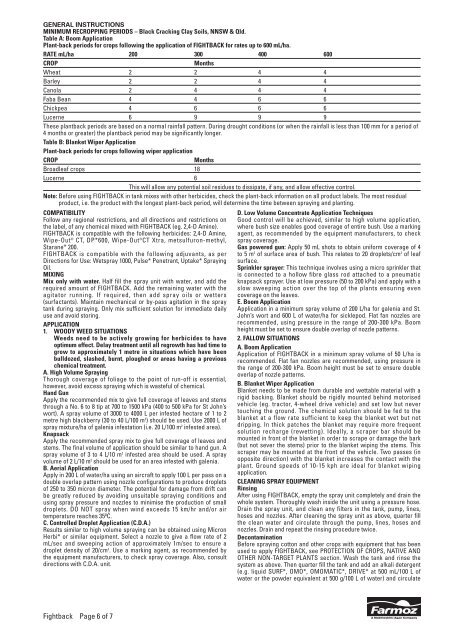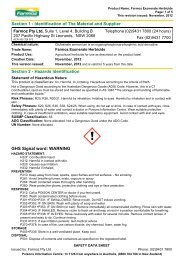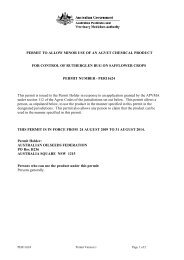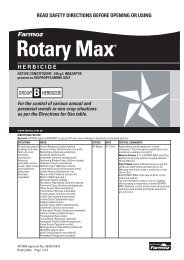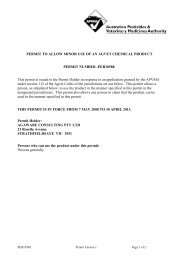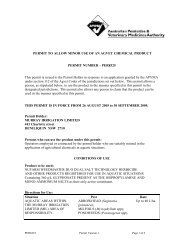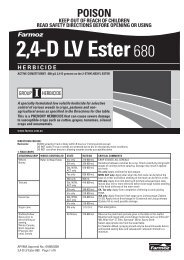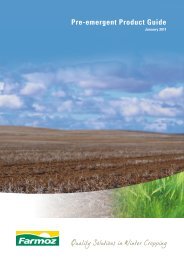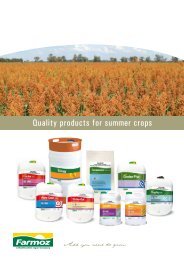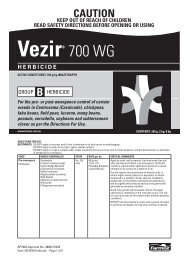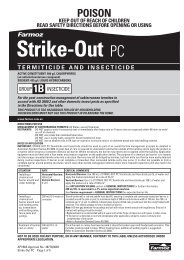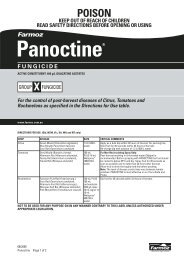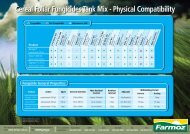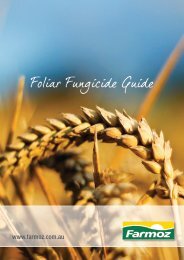Create successful ePaper yourself
Turn your PDF publications into a flip-book with our unique Google optimized e-Paper software.
GENERAL INSTRUCTIONS<br />
MINIMUM RECROPPING PERIODS – Black Cracking Clay Soils, NNSW & Qld.<br />
Table A: Boom Application<br />
Plant-back periods for crops following the application of FIGHTBACK for rates up to 600 mL/ha.<br />
RATE mL/ha 200 300 400 600<br />
CROP Months<br />
Wheat 2 2 4 4<br />
Barley 2 2 4 4<br />
Canola 2 4 4 4<br />
Faba Bean 4 4 6 6<br />
Chickpea 4 6 6 6<br />
Lucerne 6 9 9 9<br />
These plantback periods are based on a normal rainfall pattern. During drought conditions (or when the rainfall is less than 100 mm for a period of<br />
4 months or greater) the plantback period may be significantly longer.<br />
Table B: Blanket Wiper Application<br />
Plant-back periods for crops following wiper application<br />
CROP Months<br />
Broadleaf crops 18<br />
Lucerne 6<br />
This will allow any potential soil residues to dissipate, if any, and allow effective control.<br />
Note: Before using FIGHTBACK in tank mixes with other herbicides, check the plant-back information on all product labels. The most residual<br />
product, i.e. the product with the longest plant-back period, will determine the time between spraying and planting.<br />
COMPATIBILITY<br />
Follow any regional restrictions, and all directions and restrictions on<br />
the label, of any chemical mixed with FIGHTBACK (eg. 2,4-D Amine).<br />
FIGHTBACK is compatible with the following herbicides: 2,4-D Amine,<br />
Wipe-Out ® CT, DP*600, Wipe-Out ® CT Xtra, metsulfuron-methyl,<br />
Starane* 200.<br />
FIGHTBACK is compatible with the following adjuvants, as per<br />
Directions for Use: Wetspray 1000, Pulse* Penetrant, Uptake* Spraying<br />
Oil.<br />
MIXING<br />
Mix only with water. Half fill the spray unit with water, and add the<br />
required amount of FIGHTBACK. Add the remaining water with the<br />
agitator running. If required, then add spray oils or wetters<br />
(surfactants). Maintain mechanical or by-pass agitation in the spray<br />
tank during spraying. Only mix sufficient solution for immediate daily<br />
use and avoid storing.<br />
APPLICATION<br />
1. WOODY WEED SITUATIONS<br />
Weeds need to be actively growing for herbicides to have<br />
optimum effect. Delay treatment until all regrowth has had time to<br />
grow to approximately 1 metre in situations which have been<br />
bulldozed, slashed, burnt, ploughed or areas having a previous<br />
chemical treatment.<br />
A. High Volume Spraying<br />
Thorough coverage of foliage to the point of run-off is essential,<br />
however, avoid excess spraying which is wasteful of chemical.<br />
Hand Gun<br />
Apply the recommended mix to give full coverage of leaves and stems<br />
through a No. 6 to 8 tip at 700 to 1500 kPa (400 to 500 kPa for St John’s<br />
wort). A spray volume of 3000 to 4000 L per infested hectare of 1 to 2<br />
metre high blackberry (30 to 40 L/100 m 2 ) should be used. Use 2000 L of<br />
spray mixture/ha of galenia infestation (i.e. 20 L/100 m 2 infested area).<br />
Knapsack<br />
Apply the recommended spray mix to give full coverage of leaves and<br />
stems. The final volume of application should be similar to hand gun. A<br />
spray volume of 3 to 4 L/10 m 2 infested area should be used. A spray<br />
volume of 2 L/10 m 2 should be used for an area infested with galenia.<br />
B. Aerial Application<br />
Apply in 200 L of water/ha using an aircraft to apply 100 L per pass on a<br />
double overlap pattern using nozzle configurations to produce droplets<br />
of 250 to 350 micron diameter. The potential for damage from drift can<br />
be greatly reduced by avoiding unsuitable spraying conditions and<br />
using spray pressure and nozzles to minimise the production of small<br />
droplets. DO NOT spray when wind exceeds 15 km/hr and/or air<br />
temperature reaches 35ºC.<br />
C. Controlled Droplet Application (C.D.A.)<br />
Results similar to high volume spraying can be obtained using Micron<br />
Herbi* or similar equipment. Select a nozzle to give a flow rate of 2<br />
mL/sec and sweeping action of approximately 1m/sec to ensure a<br />
droplet density of 20/cm 2 . Use a marking agent, as recommended by<br />
the equipment manufacturers, to check spray coverage. Also, consult<br />
directions with C.D.A. unit.<br />
Fightback Page 6 of 7<br />
D. Low Volume Concentrate Application Techniques<br />
Good control will be achieved, similar to high volume application,<br />
where bush size enables good coverage of entire bush. Use a marking<br />
agent, as recommended by the equipment manufacturers, to check<br />
spray coverage.<br />
Gas powered gun: Apply 50 mL shots to obtain uniform coverage of 4<br />
to 5 m 2 of surface area of bush. This relates to 20 droplets/cm 2 of leaf<br />
surface.<br />
Sprinkler sprayer: This technique involves using a micro sprinkler that<br />
is connected to a hollow fibre glass rod attached to a pneumatic<br />
knapsack sprayer. Use at low pressure (50 to 200 kPa) and apply with a<br />
slow sweeping action over the top of the plants ensuring even<br />
coverage on the leaves.<br />
E. Boom Application<br />
Application in a minimum spray volume of 200 L/ha for galenia and St.<br />
John’s wort and 600 L of water/ha for sicklepod. Flat fan nozzles are<br />
recommended, using pressure in the range of 200-300 kPa. Boom<br />
height must be set to ensure double overlap of nozzle patterns.<br />
2. FALLOW SITUATIONS<br />
A. Boom Application<br />
Application of FIGHTBACK in a minimum spray volume of 50 L/ha is<br />
recommended. Flat fan nozzles are recommended, using pressure in<br />
the range of 200-300 kPa. Boom height must be set to ensure double<br />
overlap of nozzle patterns.<br />
B. Blanket Wiper Application<br />
Blanket needs to be made from durable and wettable material with a<br />
rigid backing. Blanket should be rigidly mounted behind motorised<br />
vehicle (eg. tractor, 4-wheel drive vehicle) and set low but never<br />
touching the ground. The chemical solution should be fed to the<br />
blanket at a flow rate sufficient to keep the blanket wet but not<br />
dripping. In thick patches the blanket may require more frequent<br />
solution recharge (rewetting). Ideally, a scraper bar should be<br />
mounted in front of the blanket in order to scrape or damage the bark<br />
(but not sever the stems) prior to the blanket wiping the stems. This<br />
scraper may be mounted at the front of the vehicle. Two passes (in<br />
opposite direction) with the blanket increases the contact with the<br />
plant. Ground speeds of 10-15 kph are ideal for blanket wiping<br />
application.<br />
CLEANING SPRAY EQUIPMENT<br />
Rinsing<br />
After using FIGHTBACK, empty the spray unit completely and drain the<br />
whole system. Thoroughly wash inside the unit using a pressure hose.<br />
Drain the spray unit, and clean any filters in the tank, pump, lines,<br />
hoses and nozzles. After cleaning the spray unit as above, quarter fill<br />
the clean water and circulate through the pump, lines, hoses and<br />
nozzles. Drain and repeat the rinsing procedure twice.<br />
Decontamination<br />
Before spraying cotton and other crops with equipment that has been<br />
used to apply FIGHTBACK, see PROTECTION OF CROPS, NATIVE AND<br />
OTHER NON-TARGET PLANTS section. Wash the tank and rinse the<br />
system as above. Then quarter fill the tank and add an alkali detergent<br />
(e.g. liquid SURF*, OMO*, OMOMATIC*, DRIVE* at 500 mL/100 L of<br />
water or the powder equivalent at 500 g/100 L of water) and circulate


